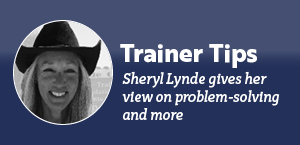 Children display individual temperaments and learning capabilities, and so do colts.
Children display individual temperaments and learning capabilities, and so do colts.
One sibling may be super chill, as nothing rattles his easygoing demeanor, while the next kid may be super sensitive, and if someone would raise their voice one octave higher, it might reduce him to tears. An older sister may be an achiever, wanting to please while respectively honoring your requests, while the younger brother may have some funk in the trunk—a “make me” attitude, annoyed at having to perform any task.
Again, it is the same with colts. I understand that I may be stating the obvious, but I meet numerous owners who become frustrated trying to use the same training approach on a different-minded colt.
We need to adjust our efforts and thoughts to fit the horse. You have to decide what kind of colt you have and how best to teach it; and it isn’t by doing a lot, but by doing a “little” regularly. This isn’t a race; sometimes, the slower you go, the more you and the colt learn.
Don’t mistake willingness for confidence. A 3-year old was brought to me to start who was very disrespectful. The owner felt she had a willing attitude, but I disagreed. She was very confident, but lacked discipline. She was an 800-pound kid who knew no boundaries. She was unsafe to lead, impatient while being tied, and very unwilling to perform tasks that were requested of her. She is one of the more difficult youngsters to start because she has a little stink in her eye, a make-me attitude that I was referring to in the first paragraph. This little mare could easily become a problem horse down the road if paired with an inexperienced rider, but that isn’t how the story needs to end.
I am for the horse. She is only three and has a long life ahead of her. My goal is to teach her good manners on the ground and in the saddle so that I can assure her the best possible future. First I need to teach her respect for my space on the ground which begins in the round pen. Outside turns (toward the rail) prepares her nicely for that as well as shoulder control. If she is sour about moving on the ground, which she was, she will continue that pattern in the saddle. If I clucked and she didn’t increase her speed, I increased the pressure of my cue by spanking her on the hip with my whip. I was careful about maintaining a safe distance from her hindquarters in anticipation of her displaying utter annoyance with a kick-out at my request, which she gave me.
Every time she did retaliate, I put her to work with a little more speed until her indignant behavior was replaced with a willingness to move her feet. Since she is confident, I know I need to bring my confidence to the saddle with every ride. I need to be clear about what I am asking her to do for each lesson—and be prepared to change the approach when needed.
More importantly, increase pressure of each cue it is ignored. I need movement in order to train, so if her reluctance to move forward was at a level 5, my cue had to be offered at a level 5.5—and increased in intervals of one second until I got the response I was looking for. If I clucked and she didn’t move, I escalated my cue by squeezing with my calf. If no response was given, I bumped with my legs, and if still no response, I spanked her hip with my reins until she moved at the speed I requested. She has one second to respond before escalating my cue. I’ve heard riders continue to cluck or kiss, and then in desperation resort to a voice command such as “come on”—but begging will only strengthen your colt’s resolve to refuse your request as she quietly smirks to herself and patiently waits for you to give up in frustration. Cluck, squeeze, bump, spank. As soon as she moves out at the speed I want, I am quiet in the saddle. If she stops or slows on her own, I start the sequence up again until eventually all I have to do is cluck and off she goes. And why? Because she understands if she doesn’t respond to the cluck, the cue will escalate to a squeeze, bump and spank every time.
I am consistent and she is aware that this rider doesn’t give up. Consistency builds mutual respect and a willingness to comply. However; different rider—different horse. In order for her to thrive in life she will need a rider that provides clear consistent boundaries.
–Sheryl
Leave a Comment
All fields must be filled in to leave a message.